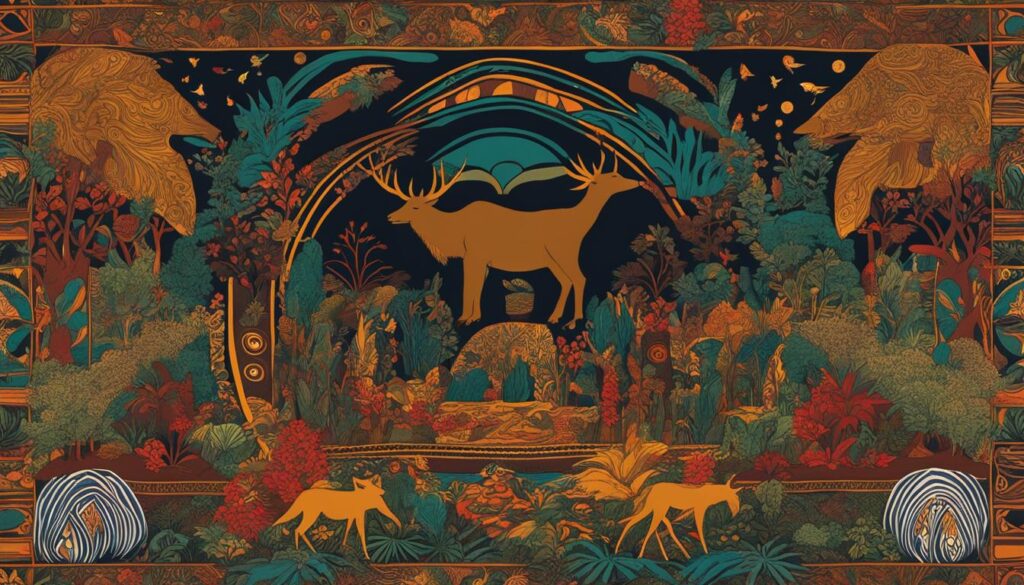Welcome to a journey of self-discovery and spiritual awakening. In this article, we will explore the concept of satori, the pinnacle of spiritual enlightenment. Experience a profound understanding of reality, find inner peace, and unlock the secrets of self-realization. Whether you are already on a spiritual path or simply curious about the mysteries of the mind, satori offers a transformative experience that transcends boundaries. Get ready to delve into the depths of mindfulness, awakening consciousness, and expanded awareness.

Key Takeaways:
- Satori is a peak spiritual experience of profound enlightenment.
- It can be attained through intense study, meditation, and the practice of koans.
- Satori is not limited to Zen Buddhism and can be experienced by individuals from various backgrounds.
- The levels of self-realization in satori offer unique perspectives on reality.
- Methods such as koans and meditation can aid in attaining satori.
The Meaning of Satori in Zen Buddhism
In the realm of Zen Buddhism, satori holds deep significance as it represents a moment of profound spiritual awakening and individual enlightenment. Rooted in the Japanese Zen tradition, satori is a direct experience of reality that surpasses analytical and logical understanding. It is a state of intuitive awareness that transcends the limitations of intellectual comprehension.
Satori is often associated with the concept of kensho, which refers to the recognition and perception of one’s true nature. While kensho and satori essentially share the same meaning, satori denotes a more profound and all-encompassing experience of enlightenment. It is considered the ultimate goal of Zen practice and is achieved through dedicated study, meditation, and the practice of koans – enigmatic riddles or questions that provoke deep contemplation.
“The goal of Zen is not to explain things, but to experience them.”
Through the rigorous and disciplined practice of Zen Buddhism, individuals embark on a journey towards satori – a state of spiritual awakening and self-realization. It is a transformative experience that goes beyond words, as it cannot be fully expressed or conveyed through language alone. The true essence of satori can only be understood through personal experience and direct realization.
The Path to Satori
The journey towards satori involves various methods and practices that facilitate the attainment of this profound state of enlightenment. One notable approach is the use of koans, which serve as tools for breaking free from conceptual limitations and reaching a state of direct experience. Zen masters often present their students with koans, challenging them to solve these enigmatic riddles and break through the barriers of conventional thinking.
Meditation, particularly Zazen meditation, is another essential practice on the path to satori. By cultivating deep self-awareness and maintaining a focused and attentive state of being, individuals open themselves up to the potential for satori to arise. Zazen meditation involves sitting in a quiet and still posture, observing the breath, and allowing thoughts to pass without attachment or judgment.
It is important to note that satori extends beyond Zen Buddhism and can be experienced by individuals from various spiritual and religious backgrounds. While the methods and practices may differ, the essence of satori remains the same – a profound moment of spiritual awakening and self-realization.
The Levels of Satori and Self-Realization
Within the journey of self-realization and spiritual enlightenment, there are different levels or varieties of satori. Each level represents a unique perspective and understanding of reality. These levels of self-realization include emotion-based or mystical satori, mind-based or intellectual satori, and desire-based or cosmic satori.
Emotion-based satori is characterized by a deep sense of connection and oneness with the world. It is often accompanied by intense feelings of love, joy, and compassion. This level of self-realization allows individuals to transcend their personal boundaries and experience a profound unity with all beings.
Mind-based satori, on the other hand, involves a deep intellectual understanding of reality. It is marked by profound insights and a clear comprehension of the nature of existence. This level of self-realization allows individuals to see beyond the limitations of their thoughts and beliefs, gaining a deeper understanding of the true nature of reality.
Desire-based satori, also known as cosmic satori, involves a transcendence of all desires and attachments. It is a state of complete surrender to the flow of life and an acceptance of whatever arises. In this level of self-realization, individuals experience a profound sense of freedom and liberation, transcending the ego and embracing the interconnectedness of all things.
“The levels of satori represent different depths of self-realization and offer unique insights into the nature of reality.”
| Levels of Satori | Description |
|---|---|
| Emotion-based Satori | A deep sense of connection and unity with all beings. |
| Mind-based Satori | A profound intellectual understanding of reality beyond thoughts and beliefs. |
| Desire-based Satori | A transcendent state of surrender and acceptance, embracing the interconnectedness of all things. |
Attaining Satori: Methods and Practices
Attaining satori, the ultimate goal of spiritual enlightenment and self-realization, can be achieved through various methods and practices. These techniques are not limited to any specific religious or spiritual tradition and can be pursued by individuals on their personal journey towards awakening.
One common method for attaining satori is through the practice of koans. Koans are riddles or questions that challenge the intellect and help transcend logical thinking. They are often used by Zen masters to guide students towards a breakthrough in understanding and realization. By contemplating these paradoxical questions, individuals can push beyond the limitations of the mind and experience a direct intuitive insight.
Another powerful practice for attaining satori is meditation, specifically Zazen meditation. Zazen involves sitting in a focused and aware state, allowing thoughts to pass without attachment or judgment. Through the continuous practice of Zazen, individuals can cultivate deep self-awareness and stillness, creating the potential for satori to arise.
| Methods and Practices | Description |
|---|---|
| Koans | Riddles or questions that challenge the intellect and help transcend logical thinking. Used by Zen masters to guide students towards realization. |
| Zazen Meditation | A form of meditation that involves sitting in a focused and aware state, allowing thoughts to pass without attachment or judgment. |
It’s important to note that satori is a deeply personal and individual experience, and the methods and practices mentioned above are not guarantees of attaining it. They serve as tools to facilitate the journey towards self-realization and spiritual awakening. Each individual’s path may be different, and what works for one person may not work for another. Exploring different practices, seeking guidance from experienced teachers, and maintaining a consistent and dedicated practice can all contribute to the cultivation of satori.
Satori Beyond Zen Buddhism
Satori, the profound experience of spiritual enlightenment and self-realization, extends beyond the boundaries of Zen Buddhism. Individuals from various spiritual and religious backgrounds have encountered this transformative awakening. One notable example is Bhagavan Sri Ramana Maharshi, an Indian sage who experienced a sudden and profound awakening to the Absolute without any formal training in Buddhism. His spiritual journey led him to a deep inner search for truth and self-realization, ultimately resulting in a powerful experience of satori.
Ch’an Buddhism, a Chinese school of Buddhism that greatly influenced Zen, also offers instances of satori-like awakenings. Through rigorous meditation practices, practitioners have reported experiencing moments of profound insight and realization, similar to the satori experienced in Zen Buddhism. These occurrences illustrate that satori transcends religious boundaries and can be attained through different paths of spiritual exploration.
“Satori is the freedom of self-existence.”
– Bhagavan Sri Ramana Maharshi
The concept of satori expands the spiritual landscape, demonstrating that profound enlightenment is not confined to a single tradition. It emphasizes the universality of the human quest for truth and inner peace. Whether one follows the path of Zen Buddhism, Ch’an Buddhism, or another spiritual practice, the pursuit of satori leads to profound awakenings and a deep understanding of reality.
Table: Notable Personalities and Schools Experiencing Satori-like Awakenings
| Name | Spiritual Tradition | Achievement |
|---|---|---|
| Bhagavan Sri Ramana Maharshi | Indian Spirituality | Profound experience of satori-like awakening to the Absolute |
| Ch’an Buddhism | Chinese Buddhism | Instances of satori-like awakenings through meditation practices |
These examples demonstrate the vastness of the spiritual realm and the unique paths individuals can take to reach profound states of enlightenment. Satori is a deeply personal and transformative experience that can be found beyond the boundaries of any specific religious or spiritual tradition. By embracing the journey towards satori, individuals can uncover their inner truths and embark on a path of deep spiritual awakening.
The Ineffability of Satori
Satori, the pinnacle of spiritual enlightenment, is often described as an experience that transcends language and defies explanation. In Zen philosophy, it is believed that words and concepts can only limit the true essence and understanding of satori. This concept of ineffability highlights the intuitive and personal nature of the experience, going beyond intellectual comprehension.
“The sound of the raindrops on the roof, the gentle rustling of leaves in the wind – these are the moments that communicate satori without the need for words,” says Zen master, Koji Suzuki.
Attempting to communicate satori through language can diminish its transformative power. Zen masters recognize this limitation and often resort to silence and non-verbal communication to convey the depth of satori. It is through silence that the true essence of satori can be experienced and understood.
Quotes from Zen Masters:
“Words can only point to the moon, but they can never fully capture its beauty and radiance.” – Zen Master Hakuin
“The wisdom of satori lies beyond the realm of language and intellect. It is an experiential truth that can only be grasped in the depths of one’s being.” – Zen Master Dogen
The ineffability of satori serves as a reminder that it is a deeply personal and transformative experience that goes beyond the limitations of language. To truly understand satori, one must embark on their own spiritual journey and embrace the possibility of non-verbal communication and intuitive understanding.
The Aesthetic of Satori in Art and Literature
The experience of satori, or spiritual enlightenment, has had a profound impact on art and literature, particularly within Zen-related traditions. The aesthetic of satori is deeply rooted in the principles of Zen aesthetics, which emphasize simplicity, directness, and a keen awareness of the present moment. This aesthetic seeks to capture the essence of satori and convey its transformative power through various artistic mediums.
One example of the aesthetic of satori in art is found in the traditional Japanese poetry form known as haiku. Haiku is a succinct and evocative form of poetry that aims to capture fleeting moments of enlightenment and the profound beauty of everyday life. Through precise language and carefully chosen imagery, haiku poets express the essence of satori and invite readers to experience moments of heightened awareness.
Zen literature also reflects the aesthetic of satori, often portraying characters who experience moments of intense clarity and profound revelations. Authors like Haruki Murakami skillfully weave themes of spiritual awakening and self-realization into their narratives, creating a sense of wonder and inspiration for readers. These literary works serve as reminders of the potential for awakening in everyday life and invite readers to explore their own paths towards self-discovery.
The Influence of Zen Aesthetics
The aesthetic of satori is closely intertwined with Zen philosophy and its emphasis on direct experience and mindfulness. Zen practitioners seek to cultivate a state of presence and an awareness of the interconnectedness of all things. This mindset is reflected in the artistic expressions that embody the aesthetic of satori.
| Zen Aesthetics | Key Characteristics |
|---|---|
| Simplicity | Zen aesthetics celebrate simplicity and minimalism, allowing the essence of an object or moment to shine through without unnecessary embellishments. |
| Transience | Impermanence is a central theme in Zen philosophy and art. The aesthetic of satori embraces the fleeting nature of existence and finds beauty in the transient moments of life. |
| Wabi-sabi | Wabi-sabi is the appreciation of the imperfect, the impermanent, and the incomplete. It is a recognition of the beauty that emerges from the natural cycle of growth, decay, and change. |
| Harmony | Zen aesthetics strive to create a sense of harmony and balance, both in art and in life. The aesthetic of satori seeks to harmonize the inner and outer worlds, creating a sense of unity and oneness. |
The aesthetic of satori captures the essence of spiritual enlightenment and self-realization, offering inspiration and contemplation to those who engage with art and literature influenced by Zen aesthetics.
By immersing themselves in the aesthetic of satori, artists and writers invite us to explore the depths of our own being and awaken to the inherent beauty and interconnectedness of the world around us.
Conclusion
Satori is a transformative experience of spiritual enlightenment and self-realization. It is a profound concept that can be attained by individuals on their journey towards inner peace and understanding. The practice of meditation, the use of koans, and the deep exploration of one’s inner self are common methods for attaining satori.
Satori is not limited to any specific religious or spiritual tradition, and it can be experienced by individuals from various backgrounds. It is a personal and intuitive experience that goes beyond intellectual comprehension. While the experience of satori is often described as ineffable, its aesthetic can be found in art, literature, and the everyday moments of life.
By embracing the journey towards satori, individuals can cultivate expanded consciousness, mindfulness, and a deeper connection with the true nature of reality. Satori offers a profound sense of inner peace and self-realization, allowing individuals to navigate life with greater clarity and wisdom.
FAQ
What is satori?
Satori is the spiritual goal of Zen Buddhism, representing the peak of spiritual enlightenment and a deep understanding of reality.
How is satori achieved?
Satori can be attained through intense study, meditation, and the practice of koans, which are riddles or questions that assist in the realization of enlightenment.
Is satori limited to Zen Buddhism?
No, satori is not limited to any specific religious or spiritual tradition and can be experienced by individuals from various backgrounds and traditions.
Can satori be described in words?
Satori is often considered an experience that cannot be fully expressed in words, as it goes beyond intellectual comprehension and is often conveyed through non-verbal means.
Are there different levels of satori?
Yes, there are different levels or varieties of satori, including emotion-based, mind-based, and desire-based satori, representing different depths of self-realization.
How can satori be experienced in everyday life?
Embracing the journey towards satori can lead to a greater sense of expanded consciousness, mindfulness, and awakening to the true nature of reality, even in everyday moments of life.
Can satori be achieved without formal training?
Yes, there have been instances of individuals experiencing satori-like awakenings without any formal training or deep knowledge of Buddhism, emphasizing the universal potential for spiritual awakening.
How does satori influence art and literature?
The experience of satori has had a significant influence on art and literature, particularly in Zen-related traditions, where it is often portrayed as moments of intense clarity and profound revelations.



